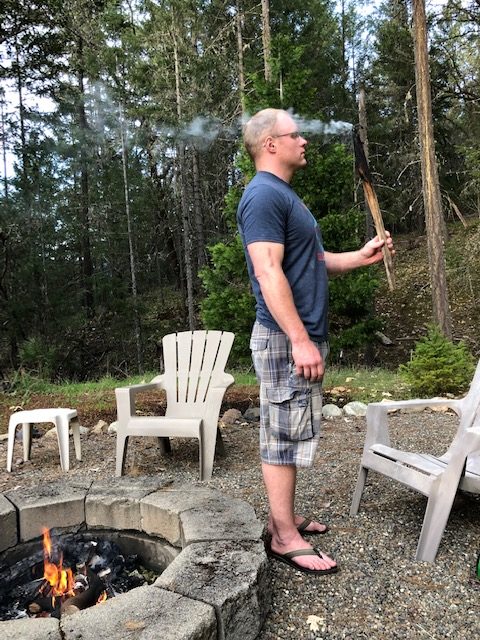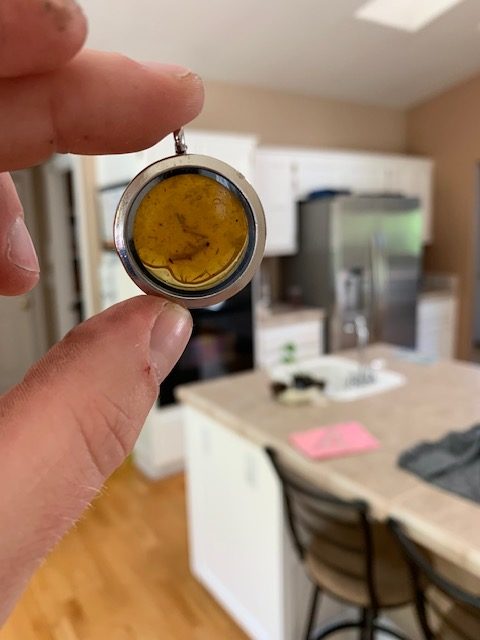
Moonshine on Easter?
No, not really I wouldn’t brew whiskey on Easter…. But I did get a chance to brew some incense cedar oil this past Easter. It was the last chance that I’d have to brew some cedar with Dan, and I had one wicked chunk of incense cedar found on our “Savage” February lower rogue trip that I had to get after. Compared to what we’ve found in past incense cedar hunts, the best adjective to describe this chunk of wood is “gnarly”.
Breaking the “gnarly” piece apart with the “kindling cracker”. Have you ever seen wood like this? Remarkable.
We found this chunk of wood, again on Whiskey creek, on our must run February lower rogue trip. Although, not advisable to travel this section of river with snow in the forecast, we had to do it. I knew I would be leaving Oregon soon, and my brother was traveling out from Indiana, and I still had not taken him on a Lower trip. A “maybe doable if you’re crazy” pocket of weather showed up for the second and third nights of Aaron’s stay. Pulled that trigger! No regrets. Dan is an easy sell on any and all crazy adventures – so the the three of us made a go of it. Aaron’s, feet almost froze off and we were hailed and snowed on during our last day in the water and drive home. But it was savage, and Aaron had a chance to help me find this beautifully saturated piece of wood. Unforgettable.
Images from the early February “Savage” Lower Rogue Trip.
I’ve alluded to distilling the essential oil out of the incense Cedarwood in prior posts, but I’ve never fully gone into the discovery of how it is accomplished. It all started a little over one year ago on our annual spring rafting trip of 2018. The “core four” had just collected fantastic grouping of incense cedar driftwood from Whiskey Creek and Horseshoe Bend on the Lower Rogue River. As you know, the four of us were already infatuated with and infecting others with the same infatuation of the beauty and purity of incense cedar. What we knew of this special wood at that point was it’s dark red Amber color, pure smell when broken, and cleansing odor, reaching deep when burned and smoking.
We knew of the enjoyment during our “hunts”, working our way upstream while grabbing hunks of driftwood that appear like it could be the magic stuff. And then having fun bashing it over rocks to break it open sticking our noses deep inside hoping to find the aroma of the incense cedar gold. What we collect, we haul out and find a way to pack it on the raft with all our gear to get it to the next campsite. Once the wood dries out just enough, the testing begins at the the campfire that evening. Placing just the tip of the spear into the fire, it does not take long for a good piece to catch since it is saturated with oil. What happens next is a glorious burst of flames from the oil rich wood. To get the desired depth of smoke aroma, it is best to put the flames out, let it catch and repeat three or four times. No other wood that I have encountered does what this wood does, it literally becomes a torch. The flames in a good piece are very stubborn to put out. Once the flame is out, the pungent smoke produces a spiritually cleansing aroma.
Trying to put out the flames, enjoying the cleansing aroma of the incense cedar smoke. The “flaming J” glowing at dusk on Horseshoe Bend.
This is what we know as incense cedar. So back to our trip around a little over a year ago, when Dan commented, “We should find a way to bottle this.” That set my mind in motion to be creative with how to actually produce this. I began my research with how different essential oils are produced. I looked into different versions of mass producing Sandalwood, which all started with being able to get the material ground finely, dried out, and then steam distilled. That seems simple enough. So I needed a still, and wouldn’t you know it, a quick Internet search led me to a whiskey still through Walmart. So I grabbed it. The next thing I would need is a way to separate the oil from the hydrosol. Hydrosol is the rest of the water produced infused with tiny droplets of oil that did not separate during the process. The other product is simply the essential oil of the plant material. Again, another quick search on Amazon led me to a science titration device that would let me drip titrate and separate the hydrosol from the oil. OK I think I have everything I needed check check check, oh and a single electric hot plate and already distilled water to start with. I would also use a modified metal vegetable steamer to keep the wood off the bottom of the pot.




The set up: the steam pot on top of the single burner, with the cooling pot above, modified vegetable steamer basket, oil titrator.
My first run was exciting, yet relatively unproductive. I basically used an axe, machete and my hands to break the wood into small pieces. I did learn how the process works. It is all pretty basic, actually. Once the water begins to boil in the sealed pot, the steam begins to seep through the wood, taking with it the essential oil. The steam with the oil travels through it’s only exit at the top of the pot. It then travels through a copper coil that is submerged in cold water residing above the steam pot. It is here that the steam condenses and liquefies back into a water substance, shooting out of the copper spout. Collected is hydrosol and essential oil. So my first go at producing oil was a little less than fruitful, leaving me with basically really dense hydrosol. I figured my issue was with the size of the plant material I steamed, which led me to yet again another internet search. I found an affordable electric wood chipper that could possibly do the trick for me. I’ll tell you what, that little Sun Joe I ended up with really did a great job chewing up the wood pieces.
Three to seven inch chunks of the gnarly wood, Sunjoe doin’ work, the finely chipped wood – I could play in all day.
Now I had something to work with: the most densely saturated, finely chipped Cedar-wood I could get. When I ran that gnarly piece through it ended up feeling almost like “kinetic sand” for those of you who have kids or grand kids currently. So I went ahead and put this on top of my modified vegetable steamer basket, filled the pot up with distilled water, and let the burner go. The time it takes to get the water and product up to heat is just about the time it takes to drink a beer. Ok two. If you have stuck through this entry up to this point – you may be thinking, “well, so what? This is simple”. Dude, I took a beautiful, natural substance and captured it! It is exciting when that oil and hydrosol come pumping out of that little copper spout.




It actually produced!! See the stream from the copper spout, oil on top of hydrosol, titrating, the actual essential oil – sealed for enjoyment!
This time within a couple minutes of producing, I could already see a layer of oil being forming on top of the hydrosol! Not more than four months prior to my first successful brew, the “core four” was camped on the Lower Rogue River whimsically stating how much we would love to bottle this scent. And here it was, in little Amber essential oil bottles (thanks again, Amazon). I did it!
However, what’s interesting is that the essential oil in its pure form without the wood fibers, although unique, just pretty much smells like Pine-Sol. Researching essential cedar oil suggests it has beneficial qualities such as giving mind clarity and body cleansing. Whether or not it does that, I’ll let you decide. I’ll never be able to claim things such as this without empirical evidence, but personally, the aroma of the oil, wood and smoke will forever bring me back to a place where I feel free and whole.
So now I have the essential oil, smelling like Pine-Sol and the hydrosol which has the same aroma, only slightly sweeter. The next question becomes, What do I do with this now? How do I capture the burning smell that we enjoy so much to share with others? I tried candles with and without wood chips out of pure soy wax and wood wicks. I even learned how to cut glass and made cool candle holders out of beer and wine bottles. It all looked cool, but alas the aroma was weak compared to what I was going for, and this used a great volume of the precious oil I had produced. I then tried incense sticks. I used unscented incense sticks (pretty much like “punks” you might have used to light fireworks in the past), and soaked them with a ratio of hydrosol, oil and dipropylene glycol. The sticks were soaked in this solution for 24 hours in a dark place, and then allowed to completely dry before burning. This aroma was was much closer to what I was going for, but of course, not quite like I was looking for.
I still haven’t figured out what to do with the cedar oil other than enjoy the fact that I tried and was actually able to captured the primary component of the aroma we enjoy so much. I also found a a little hobby on the side: extracting essential oil’s from plant material. Who knows, this could become a thing as we travel into various ecosystems with unique and memorable fragrant plants I may try to capture the fragrance as a part of sharing the essence of the location.
I created one additional unique memento out of a piece of incense drift wood during our April 2019 Raft trip. I literally stumbled upon a piece of incense cedar coated with old pitch. When I burned this piece in the camp fire, the pitch began to melt and turned into a translucent, amber colored sap. When it cooled, it became hard and britle – think Jurassic Park and the poor mosquito as I am describing this. When I got home, I scraped the pitch off, placed it in a clean tin can and melted the pitch in boiling water on the stove. I carefully took the melted pitch and poured it into a couple pendants I could save. I have decided to wear one as a necklace as a way to take a piece of the Rogue with me wherever I go. How cool is that?
Look at that crazy pitch! Melted, and then captured and cooled amber.
Will anything other than just a hobby become of this whole process? I don’t know. It was cool to be creative and try. To learn and explore. I think I’ll just leave it at that for now which is fine by me. Plus it’s another excuse to be outside and have a beer when I give it a stab again!






















